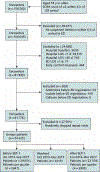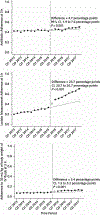Treatment Patterns and Clinical Outcomes After the Introduction of the Medicare Sepsis Performance Measure (SEP-1)
- PMID: 33872042
- PMCID: PMC8844885
- DOI: 10.7326/M20-5043
Treatment Patterns and Clinical Outcomes After the Introduction of the Medicare Sepsis Performance Measure (SEP-1)
Abstract
Background: Medicare requires that hospitals report on their adherence to the Severe Sepsis and Septic Shock Early Management Bundle (SEP-1).
Objective: To evaluate the effect of SEP-1 on treatment patterns and patient outcomes.
Design: Longitudinal study of hospitals using repeated cross-sectional cohorts of patients.
Setting: 11 hospitals within an integrated health system.
Patients: 54 225 encounters between January 2013 and December 2017 for adults with sepsis who were hospitalized through the emergency department.
Intervention: Onset of the SEP-1 reporting requirement in October 2015.
Measurements: Changes in SEP-1-targeted processes, including antibiotic administration, lactate measurement, and fluid administration at 3 hours from sepsis onset; repeated lactate and vasopressor administration for hypotension within 6 hours of sepsis onset; and sepsis outcomes, including risk-adjusted intensive care unit (ICU) admission, in-hospital mortality, and home discharge among survivors.
Results: Two years after its implementation, SEP-1 was associated with variable changes in process measures, with the greatest effect being an increase in lactate measurement within 3 hours of sepsis onset (absolute increase, 23.7 percentage points [95% CI, 20.7 to 26.7 percentage points]; P < 0.001). There were small increases in antibiotic administration (absolute increase, 4.7 percentage points [CI, 1.9 to 7.6 percentage points]; P = 0.001) and fluid administration of 30 mL/kg of body weight within 3 hours of sepsis onset (absolute increase, 3.4 percentage points [CI, 1.5 to 5.2 percentage points]; P < 0.001). There was no change in vasopressor administration. There was a small increase in ICU admissions (absolute increase, 2.0 percentage points [CI, 0 to 4.0 percentage points]; P = 0.055) and no changes in mortality (absolute change, 0.1 percentage points [CI, -0.9 to 1.1 percentage points]; P = 0.87) or discharge to home.
Limitation: Data are from a single health system.
Conclusion: Implementation of the SEP-1 mandatory reporting program was associated with variable changes in process measures, without improvements in clinical outcomes. Revising the measure may optimize its future effect.
Primary funding source: Agency for Healthcare Research and Quality.
Figures



Comment in
-
Has the Medicare Sepsis Performance Measure (SEP-1) Catalyzed Better Outcomes for Patients With Sepsis?Ann Intern Med. 2021 Jul;174(7):1010-1011. doi: 10.7326/M21-1571. Epub 2021 Apr 20. Ann Intern Med. 2021. PMID: 33872041 No abstract available.
References
-
- Liu V, Escobar GJ, Greene JD, et al. Hospital deaths in patients with sepsis from 2 independent cohorts. JAMA. 2014;312:90–2. - PubMed
Publication types
MeSH terms
Substances
Grants and funding
LinkOut - more resources
Full Text Sources
Other Literature Sources
Medical
